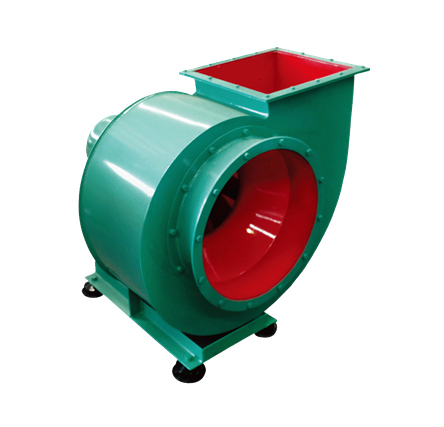A centrifugal fan is a mechanical device that accelerates gas through high-speed rotating impellers, utilizing centrifugal force to convert gas kinetic energy into pressure energy (potential energy). Its core principles include:
Kinetic Energy Conversion: Gas enters the impeller axially, becomes accelerated by the blades, then is radially discharged into the diffuser where deceleration occurs, transforming kinetic energy into pressure energy.
Multi-stage Pressure Boosting: In multi-stage fans, a return channel guides the gas into the next impeller stage, achieving higher pressure output.
How it works
When the electric motor is activated, the impeller of the fan begins to rotate. As the impeller spins, it generates centrifugal force, which propels air outward from the impeller. This expelled air accumulates within the fan housing. Due to the reduced velocity and increased pressure within the housing, the air is discharged from the fan outlet and flows into the connected pipeline.
As air is expelled from the impeller, a negative pressure zone forms within the impeller region. Consequently, external air from the intake port is forced into the impeller under atmospheric pressure. Through this continuous rotation of the impeller, air maintains a steady flow within the pipeline under the fan’s driving action.
Main Structure and Components
1.Impeller
The impeller is the core component of a fan. It consists of blades, a front shroud (disk) and a rear shroud (disk) that connect and secure the blades, and a hub. Based on the relationship between the blade’s exit direction and the impeller’s rotation, centrifugal fan blades can be categorized into three types: backward-curved, radial, and forward-curved.
The curvature direction of forward-curved blades opposes the gas’s motion trajectory. The gas is forcibly redirected, resulting in higher noise levels, greater energy loss, and lower efficiency. Radial blades exhibit characteristics intermediate between backward-curved and forward-curved designs.
2.Collector
The collector is installed in front of the impeller. Its function is to ensure that airflow uniformly fills the inlet cross-section of the impeller while minimizing resistance losses during airflow passage.
To guarantee the performance of the fan, it is critical to ensure that the clearance between the collector and the impeller inlet meets the standards specified in the engineering drawings. For fans handling high-temperature gases or larger fan models, the clearance between the inlet ring and the impeller inlet is intentionally designed to be non-uniform. This accounts for thermal expansion of the casing during high-temperature operation, preventing friction between the inlet ring and the impeller. Typically, the clearance is larger at the top and smaller at the bottom, while maintaining uniform clearance on both sides. Adjustments must ensure compliance with the clearance values required by the drawings.
3.Matching between Collector and Impeller
The sleeve joint clearance configuration is preferable for the fit between collector and impeller, while the butt joint clearance arrangement is generally less utilized in fan applications.
The performance and efficiency of a fan are primarily determined by the impeller. However, the geometry and dimensions of the volute casing, as well as the configuration of the air inlet, also exert significant influences.
The volute casing serves two essential functions:
To gather airflow discharged from the impeller and direct it towards the exhaust outlet.
To convert a portion of the dynamic pressure energy acquired from the impeller into static pressure energy during this flow process, thereby creating a certain level of air pressure.
4.Volute Casing (Scroll Casing)
(1) Sharp tongue: Used in high-efficiency fans, which generally produce higher noise levels.
(2) Deep tongue: Mostly used in low-speed fans.
(3) Short tongue: Typically applied in high-speed fans.
(4) Flat tongue: Employed in low-efficiency fans, which generate lower noise.
The clearances between the volute tongue tip and the impeller outer diameter significantly affects noise. A smaller clearance s results in higher noise, while a larger clearance s reduces noise. The recommended range is s = (0.05~0.10)D₂.
The arc radius r at the volute tongue tip has minimal impact on aerodynamic performance but strongly influences noise. A smaller radius r increases noise. The typical range is r = (0.03~0.06)D₂.
5.Volute Tongue
At the outlet of the centrifugal fan’s volute casing, there exists a tongue-shaped structure known as the volute tongue. This component prevents gas recirculation within the casing.
6.Bearing Housing
The bearing housing assembly comprises three key components: the drive shaft, bearings, and bearing pedestal.
7.Adjustment door
When installing the adjustment door, pay attention to whether the blade rotation direction of the adjustment door is correct, and ensure that the direction of air intake is consistent with the direction of impeller rotation. The most common adjustment door is the petal-shaped blade-type adjustment door, and the adjustment range is from 0° (fully open) to 90° (fully closed). The handle of the adjustment door is on the right side when viewed from the air inlet. For right-hand rotating fans, pushing the handle from bottom to top is from fully closed to fully open. For left-hand rotating fans, pulling the handle from top to bottom is from fully closed to fully open.
8.Introduction to the rotation direction of centrifugal fans:
The fan can be made into two types: right-handed or left-handed. When viewed from the motor end, if the impeller rotates clockwise, it is called a right-handed fan; if it rotates counterclockwise, it is called a left-handed fan.
Centrifugal fans, as equipment utilizing the principle of centrifugal force for gas transportation, find extensive applications across multiple fields, primarily covering industrial production, building environments, energy systems, and public facilities.
In industrial production, centrifugal fans are commonly used for workshop ventilation, dust collection, and exhaust gas treatment. Examples include welding fume filtration in metal processing plants, corrosive gas discharge in chemical plants, and clean air circulation in pharmaceutical workshops. Their stable air pressure characteristics enable critical roles in high-temperature flue gas emission (e.g., boiler induced draft systems) and material drying (e.g., grain drying equipment).
In the construction sector, centrifugal fans are widely deployed in commercial complexes, underground parking garages, and subway tunnels for ventilation and fire safety smoke extraction systems. They also serve air circulation and temperature regulation functions in central HVAC systems.
The energy industry relies on centrifugal fans for power plant boiler combustion air supply, gas turbine combustion assistance, and gas circulation cooling in nuclear facilities.
Additional applications include: Agriculture: Greenhouse climate control, livestock barn ventilation, and airflow management in grain storage. Environmental engineering: Wastewater treatment aeration and exhaust gas treatment in waste incineration processes.
The structural diversity (e.g., forward-curved or backward-inclined impellers) and material adaptability (e.g., anti-corrosion coatings, high-temperature-resistant alloys) of centrifugal fans allow them to meet demands ranging from conventional environments to specialized conditions involving corrosion, extreme heat, or humidity. As such, they have become indispensable gas-powered devices in modern industrial and civil infrastructure.
Post time: Apr-21-2025




